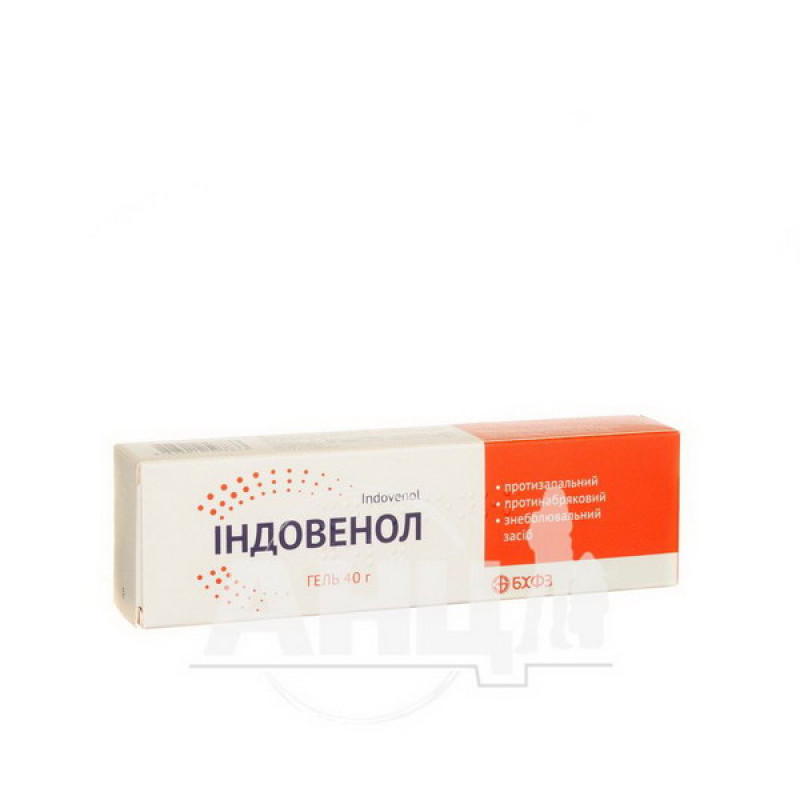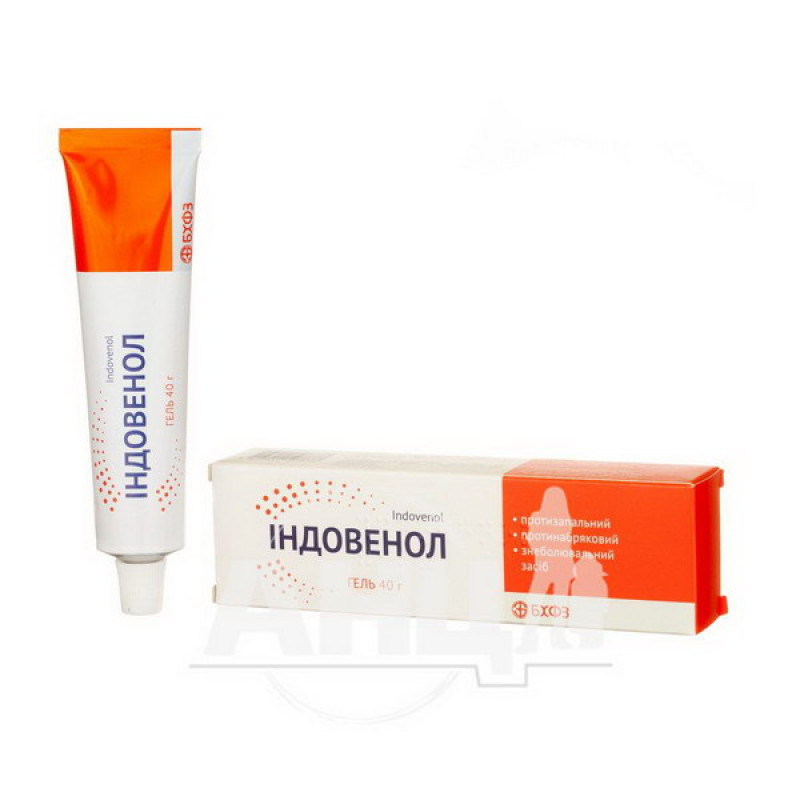Indovenol gel tube 40 g

Pharmacological properties
The pharmacological properties of Indovenol are determined by its active ingredients - troxerutin and indomethacin.
Troxerutin is a bioflavonoid with P-vitamin activity, exhibits pronounced angioprotective, venotonic, anti-inflammatory, anti-edematous, antioxidant properties, reduces the permeability and fragility of capillaries, ensures their elasticity, firmness and resistance to damage, reduces the severity of exudative inflammation in the vascular wall. As a result, it contributes to the normalization of microcirculation, improves tissue trophism, reduces stagnation in veins and perivenous tissues.
Indomethacin is a drug from the group of nonsteroidal anti-inflammatory drugs. When applied topically, it has a pronounced anti-inflammatory, analgesic, anti-edematous, and antiplatelet effect, due to the inhibition of the synthesis of prostaglandins and other inflammatory mediators.
The gel base of the drug promotes rapid and maximum release of active ingredients, as well as the creation of the necessary therapeutic concentrations in inflamed tissues and synovial fluid.
Indomethacin is 90% bound to plasma proteins. Metabolism occurs in the liver by O-demethylation and N-deacetylation to inactive compounds; 60% is excreted in the urine and 30% in the feces. Penetrates into breast milk.
Indication
Trophic disorders in chronic venous insufficiency; varicose veins accompanied by pain and swelling; musculoskeletal diseases (bursitis, tendovaginitis, myositis, synovitis); hematomas of traumatic origin.Application
The drug is used externally. About 0.5-1 g of Indovenol (a strip of gel 2.5-5 cm long) is applied in a uniform thin layer to the skin and rubbed in lightly for 1-2 minutes. After applying the drug, hands must be washed (except for applications to the hands). The procedure is repeated 2-3 times a day. The total daily dose for adults and children over 14 years of age should not exceed 5 g of gel. The duration of treatment with Indovenol should not exceed 10 days.
Contraindication
Hypersensitivity to indomethacin, troxerutin or other components of the drug; erosive-ulcerative lesions of the gastrointestinal tract, as well as conditions accompanied by bleeding from the gastrointestinal tract (including hemorrhoidal bleeding); chronic gastritis, enterocolitis; hematopoietic disorders of various etiologies; severe liver and kidney dysfunction; severe heart failure; history of allergic reactions caused by taking acetylsalicylic acid or other nonsteroidal anti-inflammatory drugs; pregnancy and breastfeeding; age up to 14 years.
Side effects
Local skin irritation in the form of hyperemia, itching, skin rashes, allergic reactions, contact dermatitis, a feeling of warmth and burning in the application area is possible, which quickly disappear after discontinuation of the drug.
The occurrence of systemic side effects after topical application of Indovenol is unlikely, however, given the possibility of prolonged use, exceeding recommended doses, application of the drug to large areas of skin, and simultaneous administration of other indomethacin drugs, the development of systemic adverse reactions is possible.
Gastrointestinal: heartburn, epigastric pain, nausea, vomiting, diarrhea or constipation. Rarely - gastrointestinal bleeding, ulcerative lesions of the oral mucosa, bleeding gums, glossitis.
From the urinary system: edema, urination disorders, hematuria, change in color or odor of urine.
From the side of the central nervous system: dizziness, headache, memory impairment, hearing and vision impairment, confusion, depression, speech disorders.
Allergic reactions: allergic rhinitis, exanthema, urticaria, angioedema, anaphylaxis, asthma attack.
Others: muscle weakness, muscle pain, jaundice, changes in laboratory parameters of peripheral blood composition, increased liver enzymes, increased blood pressure, dryness and redness of the eyes.
Special instructions
Use during pregnancy and breastfeeding.
The use of the drug during pregnancy is contraindicated. If it is necessary to use the drug, breastfeeding is recommended to be discontinued for the period of treatment.
Children: Indovenol is not used in children under 14 years of age.
Ability to influence the reaction rate when driving vehicles or working with other mechanisms. Indovenol does not affect the reaction rate when driving vehicles or working with potentially dangerous mechanisms.
Interactions
When using Indovenol, the possibility of interaction with other drugs is minimal. However, the possibility of interaction with anticoagulants and antithrombotic agents should be excluded - the risk of bleeding increases.
Indovenol may reduce the effectiveness of antihypertensive therapy by reducing the effectiveness of β-adrenergic blockers, ACE inhibitors, loop, thiazide and potassium-sparing diuretics; with simultaneous use with other NSAIDs, corticosteroids, and alcohol consumption, the ulcerogenic effect is enhanced.
Indovenol is able to reduce the tubular secretion of methotrexate and, accordingly, increase its toxicity; when used with probenecid, it is possible to reduce the uricosuric effect of probenecid and slow down the elimination of indomethacin from the body; sulfinpyrazone can slow down the elimination of indomethacin from the body; combination with myelosuppressive, antitumor, antidiabetic agents, cephalosporins, valproic acid preparations is undesirable.
Overdose
No cases of overdose have been reported. However, given the likelihood of prolonged use, exceeding recommended doses, application to large areas of skin, and simultaneous use of other indomethacin preparations, the above-mentioned side effects are possible.
Treatment: remove or wash off any remaining gel from the skin. If necessary, carry out symptomatic therapy.
Storage conditions
At a temperature not exceeding 25 °C, freezing is not allowed.
There are no reviews for this product.
There are no reviews for this product, be the first to leave your review.
No questions about this product, be the first and ask your question.



